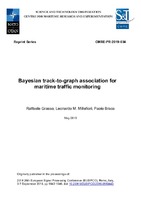| dc.contributor.author | Grasso, Raffaele | |
| dc.contributor.author | Millefiori, Leonardo | |
| dc.contributor.author | Braca, Paolo | |
| dc.date.accessioned | 2019-06-18T12:20:49Z | |
| dc.date.available | 2019-06-18T12:20:49Z | |
| dc.date.issued | 2019/05 | |
| dc.identifier.govdoc | CMRE-PR-2019-034 | en_US |
| dc.identifier.uri | http://hdl.handle.net/20.500.12489/775 | |
| dc.description.abstract | We present a hypothesis test to associate ship track measurements to an edge of a given graph that statistically models common traffic routes in a given area of interest. The association algorithm is based on the hypothesis that ship velocities are modeled by mean-reverting stochastic processes. Prior knowledge about the traffic is provided by the graph in form of probability density functions of the mean-reverting kinematic parameters for each node and edge of the graph, which are exploited in the formalization of the association algorithm. Tests on real Automatic Identification System (AIS) data show a qualitatively good association performance. Future developments of this work include the development of specific quantitative metrics to assess the association performance. | en_US |
| dc.format | 5 p. : ill. ; digital, PDF file | en_US |
| dc.language.iso | en | en_US |
| dc.publisher | CMRE | en_US |
| dc.source | In: 2018 26th European Signal Processing Conference (EUSIPCO), Rome, Italy, 3-7 September 2018, pp. 1042-1046, doi: 10.23919/EUSIPCO.2018.8553443 | |
| dc.subject | Maritime surveillance | en_US |
| dc.subject | Ship tracking | en_US |
| dc.subject | Maritime route prediction | en_US |
| dc.subject | Bayesian statistical decision theory | en_US |
| dc.subject | Stochastic processes | en_US |
| dc.subject | Graph theory | en_US |
| dc.title | Bayesian track-to-graph association for maritime traffic monitoring | en_US |
| dc.type | Reprint (PR) | en_US |
| dc.type | Papers and Articles | en_US |
